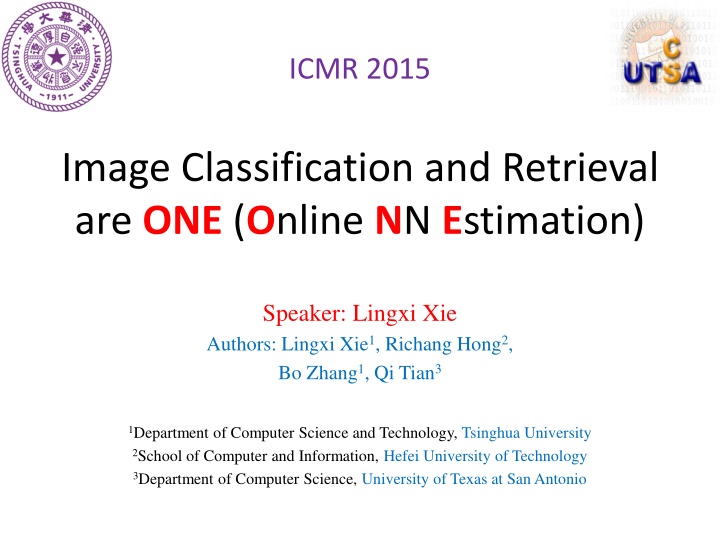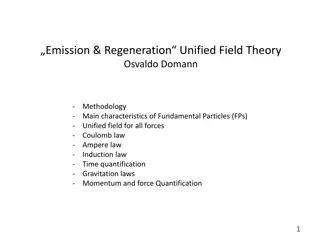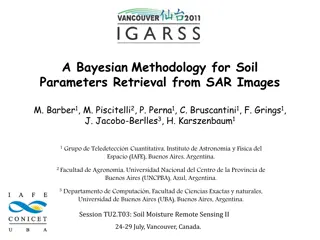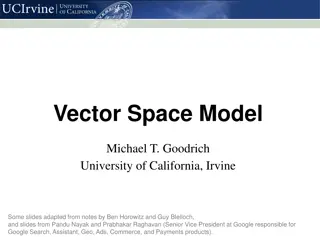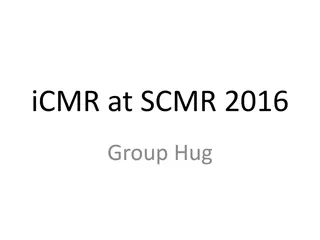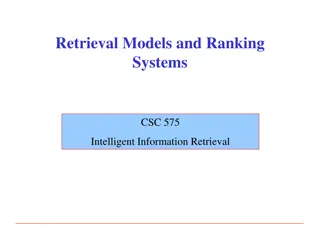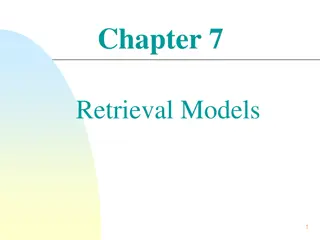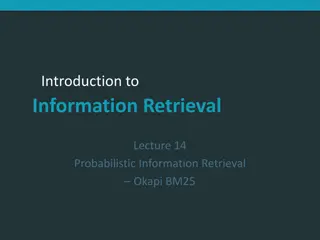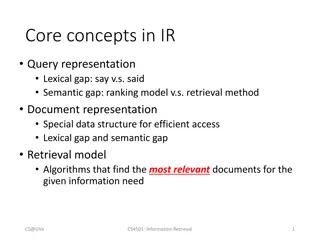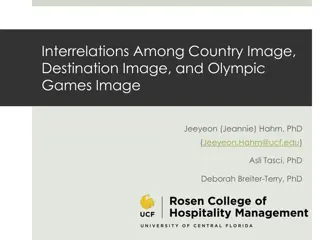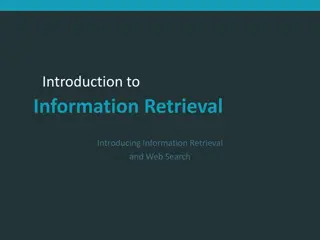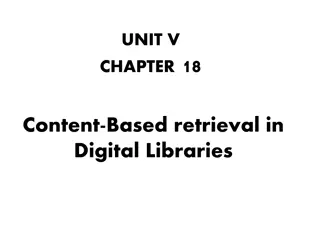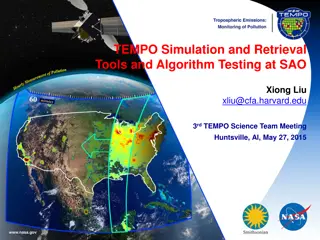Unified Model for Image Classification and Retrieval at ICMR 2015
In this study presented at ICMR 2015, the focus is on a unified model that combines image classification and retrieval. The goal is to address differences between the two tasks and explore the benefits of a unified approach. Researchers Lingxi Xie, Richang Hong, Bo Zhang, and Qi Tian delve into the ONE algorithm and its experimental results to draw conclusions on this innovative model.
Download Presentation

Please find below an Image/Link to download the presentation.
The content on the website is provided AS IS for your information and personal use only. It may not be sold, licensed, or shared on other websites without obtaining consent from the author.If you encounter any issues during the download, it is possible that the publisher has removed the file from their server.
You are allowed to download the files provided on this website for personal or commercial use, subject to the condition that they are used lawfully. All files are the property of their respective owners.
The content on the website is provided AS IS for your information and personal use only. It may not be sold, licensed, or shared on other websites without obtaining consent from the author.
E N D
Presentation Transcript
ICMR 2015 Image Classification and Retrieval are ONE (Online NN Estimation) Speaker: Lingxi Xie Authors: Lingxi Xie1, Richang Hong2, Bo Zhang1, Qi Tian3 1Department of Computer Science and Technology, Tsinghua University 2School of Computer and Information, Hefei University of Technology 3Department of Computer Science, University of Texas at San Antonio
Outline Introduction Image Classification and Retrieval Conventional BoVW Model Goal and Motivation The ONE Algorithm Experimental Results Conclusions 10/4/2024 ICMR 2015, Shanghai, China 2
Outline Introduction Image Classification and Retrieval Conventional BoVW Model Goal and Motivation The ONE Algorithm Experimental Results Conclusions 10/4/2024 ICMR 2015, Shanghai, China 3
Introduction: Image Classification BIRD Black-foot. Albatross Chihuahua DOG DOG FLOWER daffodil FLOWER Image Dataset Groove-billed Ani Siberian Husky snowdrop Bird-200 Dog-120 Flwr-102 Rhinoceros Auklet Colts foot Golden Retriever FLOWER ? DOG ? Test Colts foot Siberian Husky 10/4/2024 ICMR 2015, Shanghai, China 4
Introduction: Image Retrieval Image Dataset Holiday QUERY QUERY TP TP TP TP Test True- Positive TP FP TP FP TP False- Positive FP 10/4/2024 ICMR 2015, Shanghai, China 5
BoVW for Classification & Retrieval COMMON PART COMMON PART classification classification global features raw images visual features A Img. 1 Img. 2 Img. 3 B Img. 2 Img. 4 Img. 5 image descriptors visual vocabulary inverted file retrieval retrieval 10/4/2024 ICMR 2015, Shanghai, China 6
Outline Introduction Image Classification and Retrieval Conventional BoVW Model Goal and Motivation The ONE Algorithm Experimental Results Conclusions 10/4/2024 ICMR 2015, Shanghai, China 7
The Goal Designing a UNIFIED model: image classification image retrieval for Answering two questions: What is the difference between them? Can we benefit from the unified model? 10/4/2024 ICMR 2015, Shanghai, China 8
Classification vs. Retrieval QUERY QUERY (library) sitting people tidy shelves chessboard tidy shelves sitting people laptops library arches open spaces square table bookstore 6 library attr. bookstore attr. neutral attr. dense books tidy shelves square tables 2 Q 3 7 1 5 ladder pictures square tables With Classification 4 With Retrieval dense books tidy shelves square tables cashier various styles square tables standing people sparse books square tables 10/4/2024 ICMR 2015, Shanghai, China 9
Any Inspirations? Fact 1: classification tasks benefit from extra information (image labels)! Fact 2: image-to-class distance is more stable than image-to-image distance. Classification with NN search? Retrieval with class labels? Solution: defining the class for retrieval: 10/4/2024 extracting multiple objects for each image! ICMR 2015, Shanghai, China 10
Outline Introduction Image Classification and Retrieval Conventional BoVW Model Goal and Motivation The ONE Algorithm Experimental Results Conclusions 10/4/2024 ICMR 2015, Shanghai, China 11
ONE: Online NN Estimation Measuring image-to-class distance! For classification, we have spontaneous categories. For retrieval, each image forms a category! Terminology Category: 1,2, ,? , for retrieval, ? = ?. Image: ?, each with a category label. Object proposal set: ?, ? = ?. Feature: ?, each object corresponds to a feature. Feature set: ?, all features in category ?. 10/4/2024 ICMR 2015, Shanghai, China 12
ONE: Online NN Estimation How to compute image-to-class distance? image-to-class distance dist ?0,? dist ?0, ? = ?0 ?=1 = ?0 ?=1 Naive-Bayes Nearest Neighbor (NBNN) Boiman et.al, In Defense of Nearest-Neighbor based Image Classification, CVPR 08 1 ?0dist ?0,?, ? 2 1 ?0min ?0,? ? 2 ? ? 10/4/2024 ICMR 2015, Shanghai, China 13
ONE: Online NN Estimation Class 1 1 1 1 1 1 Feature Space 10/4/2024 ICMR 2015, Shanghai, China 14
ONE: Online NN Estimation Class 2 1 2 2 1 2 2 1 2 1 1 Feature Space 10/4/2024 ICMR 2015, Shanghai, China 15
ONE: Online NN Estimation Class 3 3 1 2 2 3 3 1 2 2 3 1 2 1 3 1 Feature Space 10/4/2024 ICMR 2015, Shanghai, China 16
ONE: Online NN Estimation Test Case 3 1 2 2 3 3 1 2 2 3 1 2 1 3 1 Feature Space 10/4/2024 ICMR 2015, Shanghai, China 17
ONE: Online NN Estimation 3 1 2 2 3 3 1 2 2 3 1 2 1 3 1 Feature Space 10/4/2024 ICMR 2015, Shanghai, China 18
ONE: Online NN Estimation Classification? Retrieval? Class 1 3 Rank 3 1 2 2 3 3 1 2 Class 2 2 Rank 1 3 1 2 1 3 Class 3 1 Rank 2 Feature Space 10/4/2024 ICMR 2015, Shanghai, China 19
What is the Benefit? QUERY QUERY Search by natural scene TP TP mountain Search by mountain TP terrace Search by terrace TP TP TP natural scene Fused Results TP TP TP TP TP 10/4/2024 ICMR 2015, Shanghai, China 20
Definition of Object Proposals Manual Definition vs. Automatic Detection In experiments: In experiments: both produce satisfying For simplicity: For simplicity: we use manual satisfying performance! manual definition in evaluation. 10/4/2024 ICMR 2015, Shanghai, China 21
Time & Memory Costs Dataset scale ? candidate images (~106) ? object proposals for each image (~102) ?-dimensional features for each object (4096) FOR ONE SINGLE QUERY O ? ?? ? = O ??2? # querying features Time Complexity # indexed features O ? ? ? = O ??? Memory Complexity 10/4/2024 ICMR 2015, Shanghai, China 22
Approximation Approximate NN search! PCA reduction: from ? to ? (512) dimensions Product Quantization (PQ) approximation: ? (32) segments, each with ? (4096) codewords. FOR ONE SINGLE QUERY O ? ?? ? + ? ? ? PQ cost in summation Time Complexity codebook costs O ?? ? log2? + ? ? Memory Complexity 10/4/2024 ICMR 2015, Shanghai, China 23
Parallelization Why parallelization? PQ needs a huge amount of regular computations In comparison, conventional BoVW models with either SVM or inverted index is difficult to parallelize GPU: the most powerful devices for parallelization After using GPU 30-50x speed up based on PQ Only ~1s for each query among 1M images 10/4/2024 ICMR 2015, Shanghai, China 24
Outline Introduction Image Classification and Retrieval Conventional BoVW Model Goal and Motivation The ONE Algorithm Experimental Results Conclusions 10/4/2024 ICMR 2015, Shanghai, China 25
Experiments: Image Classification Fine-Grained Object Recognition The Pet-37 dataset (7390 images) The Flower-102 dataset (8189 images) The Bird-200 dataset (11788 images) Scene Recognition The LandUse-21 dataset (2100 images) The Indoor-67 dataset (15620 images) The SUN-397 dataset (108954 images) 10/4/2024 ICMR 2015, Shanghai, China 26
Results: Fine-Grained Recognition Pet-37 Flower-102 Bird-200 Wang, IJCV14 59.29% 75.26% N/A Murray, CVPR14 56.8% 84.6% 33.3% Donahue, ICML14 N/A N/A 58.75% Razavian, CVPR14 N/A 86.8% 61.8% Ours (ONE) 88.05% 85.49% 59.66% 89.50% 86.24% 61.54% SVM with deep feat. 90.03% 86.82% 62.02% ONE+SVM 10/4/2024 ICMR 2015, Shanghai, China 27
Results: Scene Recognition LandUse-21 Indoor-67 SUN-397 Kobayashi, CVPR14 92.8% 63.4% 46.1% Xie, CVPR14 N/A 63.48% 46.91% Donahue, ICML14 N/A N/A 40.94% Razavian, CVPR14 N/A 69.0% N/A 94.52% Ours (ONE) 68.46% 53.00% 69.61% 54.47% SVM with deep feat. 93.98% 94.71% 70.13% 54.87% ONE+SVM 10/4/2024 ICMR 2015, Shanghai, China 28
Experiments: Image Retrieval Near-Duplicate Image Retrieval The Holiday dataset (1491 images) 500 image groups, 2-12 images per group Evaluation: the mAP score The UKBench dataset (10200 images) 2550 object groups, 4 objects per group Evaluation: the N-S score The Holiday+1M dataset Holiday mixed with 1 million distractor images 10/4/2024 ICMR 2015, Shanghai, China 29
Results: Image Retrieval Holiday UKBench Holiday+1M Zhang, ICCV13 0.809 3.60 0.633 Zheng, CVPR14 0.858 3.85 N/A Zheng, arXiv14 0.881 3.873 0.724 Razavian, CVPR14 0.843 N/A N/A 0.887 3.873 Ours (ONE) N/A BoVW with SIFT 0.518 3.134 N/A 0.899 3.887 0.758 ONE+BoVW 10/4/2024 ICMR 2015, Shanghai, China 30
Outline Introduction Image Classification and Retrieval Conventional BoVW Model Goal and Motivation The ONE Algorithm Experimental Results Conclusions 10/4/2024 ICMR 2015, Shanghai, China 31
What have we Learned? Image classification and retrieval: difference Classification benefits from extra labels. Measuring image-to-class distance is more stable! Image classification and retrieval: connections Both are dealing with image similarity! From retrieval to category: pseudo labels. ONE ONE (O Online N Nearest-neighbor E Estimation) A unified model for classification and retrieval. difference? connections? 10/4/2024 ICMR 2015, Shanghai, China 32
Why ONE Works Well? Measuring image Theory: NBNN [Boiman, CVPR 08]. Generalizing to image retrieval: pseudo labels. How to perform excellent classification/retrieval? Good detection (object proposals definition). Good description (deep conv-net features). Make it fast: approximation and acceleration. GPU might be the trend of big-data computation. image- -to to- -class class distance. 10/4/2024 ICMR 2015, Shanghai, China 33
Thank you! Questions please? 10/4/2024 ICMR 2015, Shanghai, China 34
